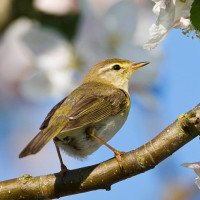Descripción
Wysokie Hill is easy-to-see, it is the highest point in the area. Barren at the top, covered mostly by meadows from SW and NE, by larch forest culture from SE and mixed shrubbery with trees from NW.
The meadows are nesting places of Alondra Común and Escribano Cerillo. Larch forest edges have great concentrations of singing Mosquitero Musical and Bisbita Arbóreo. Shrubbery from NW is home to Tórtola Europea, Curruca Gavilana, Curruca Zarcera, Curruca Zarcerilla and Acentor Común. Sometimes the area gets visited by Pico Dorsiblanco.
Many birds of prey can be seen regularly hunting in areas below: Águila Pomerana, Aguilucho Lagunero Occidental, Aguilucho Cenizo, Gavilán Común, Busardo ratonero, Cernícalo vulgar and during winter also Aguilucho pálido and Busardo Calzado.
There is a chance to see some other species during migration, i.e.: Abejero Europeo, Cernícalo Patirrojo and Halcón Peregrino.
Other common species: Cuco Común, Cigüeña Blanca, Pico Picapinos, Alcaudón Dorsirrojo, Alcaudón Norteño, Arrendajo Euroasiático, Cuervo Grande, Carbonero Garrapinos, Carbonero Palustre, Carbonero Montano , Buscarla Pintoja, Golondrina Común, Mito Común, Curruca Capirotada, Reyezuelo Sencillo, Agateador Euroasiático, Zorzal Real, Tarabilla Norteña, Tarabilla común, Picogordo Común, Pardillo Común, Jilguero Europeo.
Detalles
Accesso
Accessible from Nowosielce and Pielnia villages - by foot/bike/car/etc. Public transport to these villages limited to buses from Sanok or Krosno. Best to explore by foot, eventually by bike or 4x4 vehicle (not advised and may be problematic). Best to leave larger vehicles somewhere in a village and enjoy the trail by-foot. Field roads are rather dry and don't require rain boots.
Terreno y habitat
Árboles y arbustos dispersos , Bosque , Pradera , Meseta , Valle , Llanura , AgriculturaCondiciones
Montañoso , Seco , Paisaje abierto , PolvorientoCamino circular
Sí¿Se necesita telescopio?
Puede ser útilBuena época para el avistamiento de aves
Todo el añoMejor momento para visitar
Migración de primavera , Migración de otoño , Verano , PrimaveraRuta
Camino sin asfaltar , Camino ancho , Camino estrechoCamino difícil de andar
Caminata mediaAccesible vía
A pie , BicicletaEscondite de observación / plataforma
NoInformación extra
There aren't really any species here that'd require audio stimulation to show up. Please, avoid doing so. Different birds of prey can be seen during different parts of the day (usually smaller species in the morning and afternoon, larger show up when air is warm enough to soar).
Hazards: ticks, deep snow (winter). Keep in mind presence of other people (hunters, off-road enthusiasts, deltatrike/plane enthusiasts, wanderers), especially during weekends it can get quite busy.




